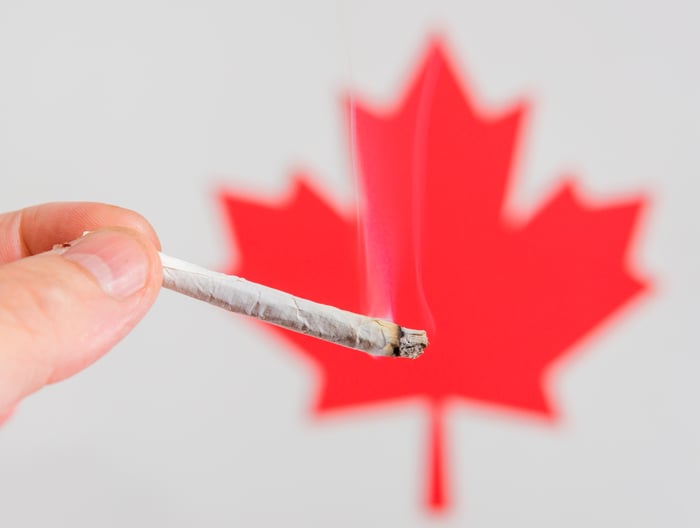The green rush is nearly upon us. In just 15 days, on Oct. 17, the green flag will wave in Canada, marking the official start of recreational marijuana sales in licensed dispensaries. Despite being a long time coming, the legalization of adult-use weed in Canada should yield billions of dollars in added annual sales for the industry, once it's fully ramped up.
This large expected influx of demand, and the belief that pot stocks will be rolling in the dough, has sent marijuana stock valuations through the roof in recent months. But no marijuana stock has caught fire to the extent of Tilray (TLRY), which has only been a publicly traded company for about two and a half months after pricing its shares at $17.

Image source: Getty Images.
In September, shares of Tilray tripled in less than three days, hitting $300 a share on an intraday basis, and peaked at a valuation of $28 billion, making it briefly worth more than widely followed companies such as Twitter and CBS. In the days that followed its rapid ascension, Tilray would lose roughly two-thirds of its value. It was a ride reminiscent of internet stocks before the popping of the dot-com bubble, and the stock has remained volatile ever since.
However, the grim reality for Tilray and its shareholders is that it could easily lose another 50% of its value, if not more. Here are four reasons investors should be worried about Tilray in the interim and expect further downside.
1. Tilray's production capacity is nowhere near the Big Three (at least not yet)
To begin with, Tilray's peak production isn't anywhere near to being on par with the "Big Three" growers in Canada: Aurora Cannabis (ACB 14.59%), Canopy Growth Corp. (CGC 26.19%), and Aphria (NASDAQOTH: APHQF). Though there's more to running a successful cannabis company than simply producing as much marijuana as possible, Aurora Cannabis, Canopy Growth, and Aphria are on track to produce more than 600,000 kilograms, more than 500,000 kilograms, and 255,000 kilograms, respectively, when at full capacity.
Meanwhile, Tilray is expected to have 912,000 square feet of land developed by the end of the year, including a little over 850,000 square feet for growing. This should yield (an author estimated) 75,000 kilograms to 85,000 kilograms a year, which is a far cry from what Aurora Cannabis, Canopy Growth, and Aphria bring to the table. Yet, Tilray's valuation handily eclipses all of the Big Three growers, which makes little sense.

Image source: Getty Images.
2. It won't turn a profit for at least another two or three years
It's not that Tilray doesn't have the ability to become a major grower. It has up to 3.8 million square feet of land at its disposal, 3.6 million of which could be devoted to growing. Because the company is expected to expand its production capacity moving forward, as well as build up its existing medical cannabis brands and international exposure, its costs are liable to exceed its revenue for the foreseeable future. Or, in plain English, the company is going to lose money.
Canopy Growth Corp. is also expected to lose money in fiscal 2019, but it has far more intangibles in its back pocket than Tilray. For example, Corona and Modelo beer maker Constellation Brands has invested more than $4 billion into Canopy Growth over the past year, inclusive of its convertible note stake from June 2018. Therefore, Canopy Growth's balance sheet is brimming with cash (or will be, once regulators approve Constellation's latest equity investment).
Canopy Growth also has what's arguably the most vertically integrated distribution system in the industry, as well as the best-known brand (Tweed) in its portfolio. Its valuation, while a stretch, is backed by other factors. Tilray simply doesn't have those intangibles to lean on to support its current market cap.
3. The lock-up period is likely to sap its strength
Another genuine concern is the expiration of the company's lock-up period, 180 days after making its on the Nasdaq.
Beginning on Jan. 15, company insiders who've been barred from selling a single share of stock will be free to cash in some, or all, of their position. The simple fact that insiders haven't been able to sell out has been one of the many forces driving Tilray's stock higher. However, with shares of the company catapulting higher from its $17 per share offering price on July 18, it's increasingly likely that insiders will cash at least some of their holdings out come January.

Image source: Getty Images.
4. Canada's supply-and-demand outlook is still sketchy, at best
A broad-based issue that could impact Tilray, and the rest of its peers for that matter, is the supply and-demand outlook.
On the demand side of the equation, it's widely expected that consumers will gobble up everything that growers produce, either domestically or through exports to foreign countries where medical cannabis is legal. But what many investors are probably overlooking is the persistence of the black market. The mere fact that Canada will be taxing recreational marijuana (albeit at a low excise tax of approximately 10%), and collecting tax from profitable businesses, means that illicit producers will be able to undercut legal-channel pricing. In other words, demand could underwhelm because of the black market.
By a similar token, growers have incentive to reap the rewards of initial consumer euphoria and high per-gram cannabis prices by overproducing. In Colorado, Washington, and Oregon, oversupply led to a precipitous decline in dried flower pricing shortly after legalization. Canadian growers could suffer the same fate, which would weigh on margins.
With history also suggesting that marijuana stocks are in a bubble, don't be surprised if Tilray sheds 50% or more of its value in the months to come.





